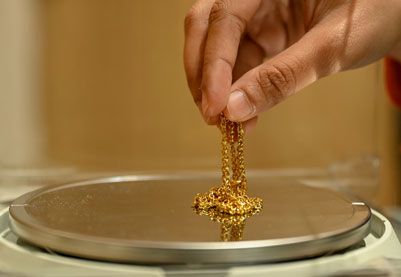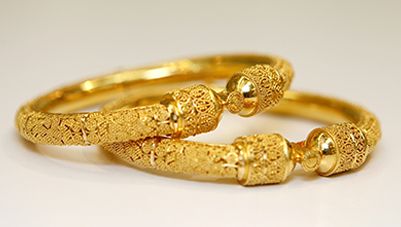5 Gram Gold Rate in India
Understanding the value of 5 gram gold
Understanding the 5 gram gold price in India involves checking the current market rate, which changes daily due to global and local factors. Multiply this rate by five to find the base gold value. For instance, if gold costs Rs. 5,000 per gram, the total becomes Rs. 25,000. When purchasing jewellery, remember to include making charges that vary by design, as well as a 3 per cent Goods and Services Tax on the gold value. For investment options like coins or bars, dealers may charge slightly higher than the spot price. Always confirm the purity, usually 22-carat or 24-carat, to determine the 5 gram gold price today accurately.
Current 5 gram gold price today
The current price for 5 grams of gold today is Rs. 49,200 for 24 karat gold. This value fluctuates based on various market conditions, including global economic trends, currency exchange rates, and local demand. Gold prices have shown a steady increase over the past few weeks, reflecting growing investor interest and economic uncertainties. Today’s price is slightly higher compared to the previous days, indicating a continuing upward trend. Investors and buyers often monitor these prices closely to make informed decisions on purchasing or selling gold. It’s advisable to check with local jewellers or financial news websites for the most accurate and up-to-date pricing.
Factors that affect the 5 gram gold rate in India
The gold rate often changes from one day to the next, and there are several reasons behind these daily fluctuations. Understanding them helps you make smarter buying or selling decisions.
- Global market trends: The international price of gold is a major factor. If global gold prices rise due to market demand, uncertainty, or geopolitical events, the local rate in India also increases.
- Currency value: The Indian Rupee’s strength against the US Dollar plays a key role. When the Rupee weakens, imported gold becomes costlier, affecting the gold rate in India today.
- Demand and supply: Festive seasons, wedding trends, and local demand also impact rates. Higher demand can push prices up.
- Government policies and import duties: Any changes in customs duty or taxation on gold affect pricing at the state level.
- Inflation and interest rates: Investors often turn to gold when inflation is high or interest rates are low, which increases demand and influences price.
Because of these combined factors, the gold rate in India today might not match yesterday’s price. To make the most of these price movements, keep track of the daily rate and check your gold loan eligibility if you are planning to unlock funds through your gold.
Why does the 5 gram gold price today differ from yesterday's 5 gram gold price?
The price of 5 grams of gold today can differ from yesterday due to several reasons. Primarily, gold prices are influenced by global market trends and economic indicators. If there is an economic event or news that impacts investor sentiment, it can lead to fluctuations in gold prices. Additionally, changes in currency exchange rates, particularly the value of the Indian Rupee against the US Dollar, can cause daily price variations. Market demand and supply dynamics also play a role, with higher demand or limited supply leading to price increases. Speculative trading and changes in government policies, such as import duties and taxes, can further contribute to daily price differences.
Historical 5 gram gold price
Understanding the 5 gram gold price history helps investors track fluctuations and identify the best time to buy. Over the years, gold has steadily appreciated in value due to inflation, global demand, and currency movements. Analysing the past 5 gram gold value provides insights into long-term growth and investment stability. Prices have generally risen year on year, reflecting gold’s resilience as a dependable asset. Below is an approximate trend of gold rates over recent years in India.
| Year | Average gold rate (1g) | Approx. 5 gram gold value |
|---|---|---|
| 2020 | Rs. 4,700 | Rs. 23,500 |
| 2021 | Rs. 4,800 | Rs. 24,000 |
| 2022 | Rs. 5,000 | Rs. 25,000 |
| 2023 | Rs. 5,300 | Rs. 26,500 |
| 2024 | Rs. 6,000 | Rs. 30,000 |
| 2025 | Rs. 6,400 | Rs. 32,000 |
(Note: The 2025 value is an estimated average based on the rising trend in gold prices across previous years.)
Taxes and making charges on 5 gram gold
When purchasing gold in India, buyers should understand how additional costs affect the total price. The GST on 5 gram gold is currently 3 per cent of the total gold value, applied to the base price. This tax directly influences the final purchase amount, whether it is jewellery, coins, or bars. Apart from taxes, buyers also pay making charges, which depend on design complexity and jeweller policy. These making charges in India typically range from 5 to 12 per cent of the gold cost. For intricate handmade jewellery, the charge can be higher, whereas machine-made items usually attract lower costs.
The impact of GST on 5 gram gold price
The implementation of the Goods and Services Tax (GST) in India has a significant impact on gold prices. GST is levied at 3% on the value of gold, in addition to the making charges. This tax adds to the overall cost of purchasing gold, making it slightly more expensive for buyers. While the intention behind GST is to streamline the tax system, it has led to an increase in the final price paid by consumers. Moreover, compliance with GST regulations has added administrative costs for jewellers, which are often passed on to customers. Despite this, gold remains a popular investment due to its intrinsic value and potential for appreciation.
Got gold jewellery lying idle? Put it to work—check your gold loan eligibility and unlock its true value today.
Techniques to check the purity of 5 gram gold
Key things to remember before buying gold:
- Hallmarking: Look for the Bureau of Indian Standards (BIS) hallmark on the gold. This mark certifies that the gold meets specific purity standards. The hallmark includes the BIS logo, the carat value, and the hallmarking centre's mark. This is one of the most straightforward ways to ensure authenticity.
- Magnet tests: Pure gold is non-magnetic. Use a strong magnet to test the gold; if it is attracted, the gold contains other metals and is not pure. This test is simple but not always definitive, as some alloys can be non-magnetic as well.
- Acid test: A jeweller can apply a small drop of nitric acid to a tiny portion of the gold. Pure gold will not react to the acid, while lower purity gold will show a reaction, such as discolouration. This test should be performed by a professional to avoid damage.
- Electronic testing: These devices measure the gold’s electrical conductivity to determine purity. Reputed jewellers use electronic testers for quick and accurate results, providing a reliable assessment without damaging the gold.
- Density test: Gold has a specific density of 19.32 g/cm³. A jeweller can measure the gold's density by weighing it and calculating its volume using displacement methods. This test helps verify purity as pure gold will consistently show this density.
Using these techniques will help ensure the purity of your 5 grams of gold, providing confidence in your investment.
Before you pledge your gold, know your options. Check yoru gold loan eligibility and choose the right amount and tenure.
The advantages of buying/ investing in 5 gram gold price
Investing in 5 grams of gold offers several advantages:
- Investing in gold is a reliable way to protect your wealth, and understanding the 5 gram gold price today helps you make informed decisions.
- Gold is a tangible asset that retains its worth, especially during uncertain economic conditions.
- The 5 gram gold value makes it an affordable option for small investors seeking long-term security.
- It is highly liquid and can be easily sold or purchased in the market whenever needed.
- Physical gold acts as a hedge against inflation and currency fluctuations.
- The 5 gm gold price today also supports portfolio diversification, helping reduce overall financial risk.
What is the best investment option: Physical gold, gold ETFs, or sovereign gold bonds?
When considering the best gold investment option, it’s important to evaluate each choice based on your financial goals, preferences, and risk tolerance. Here’s a detailed comparison of physical gold, gold ETFs, and sovereign gold bonds:
1. Physical gold
- Tangible asset: Owning physical gold, such as coins or jewellery, offers the security of a tangible asset. It is ideal for those who prefer direct ownership and have a long-term perspective.
- Costs: Involves additional costs like storage and insurance to protect against theft or damage. There are also making charges if buying jewellery.
- Liquidity: While it can be sold easily, converting physical gold to cash may not be as quick as other options, and selling might incur additional costs.
2. Gold ETFs (Exchange-Traded Funds)
- Liquidity and trading: Gold ETFs are traded on stock exchanges, providing high liquidity and ease of trading. They closely track the price of gold and can be bought or sold quickly.
- No physical ownership: Investing in ETFs means you do not own physical gold, which eliminates issues related to storage and insurance.
- Expense ratio: ETFs have management fees and expense ratios that can affect overall returns. However, they do not provide any physical gold or tangible asset security.
3. Sovereign gold bonds
- Interest and safety: Issued by the government, these bonds offer periodic interest payments, making them a secure investment. They are also free from the risks of theft and do not require physical storage.
- Tax benefits: The interest earned on sovereign gold bonds is tax-free, and capital gains from these bonds are also exempt from tax if held till maturity.
- Price appreciation: Bonds offer the potential for price appreciation aligned with the gold price, providing a safe investment with the added benefit of interest income.
Choosing the best option
- Liquidity needs: If you need quick access to cash, gold ETFs may be preferable due to their ease of trading.
- Safety and tangibility: If you value holding physical assets and can manage the associated costs, physical gold might be suitable.
- Income and safety: For a secure investment with added benefits like interest and tax advantages, sovereign gold bonds are an attractive option.
Ultimately, the best choice depends on your individual preferences regarding liquidity, safety, and potential returns. Consider diversifying your investments to balance the benefits and risks associated with each option.
Whether it is a festival or a financial need, your gold can help. Checking your gold loan eligibility and take the next step.
Things to consider before buying 5 gram gold price
Before purchasing 5 grams of gold, consider the following:
- Purity: Ensure the gold is of high purity, preferably 24 carats or 22 carats for investment purposes.
- Certification: Look for BIS hallmark certification to guarantee authenticity.
- Price: Compare prices from multiple sellers to ensure you get a fair deal.
- Making charges: Be aware of the making charges, which can vary significantly between jewellers.
- Reputation of seller: Purchase from a reputable and trusted jeweller to avoid counterfeit products.
- Buyback policy: Check the seller’s buyback policy in case you wish to sell the gold in the future.
- Market trends: Stay informed about current market trends to buy at the right time.
How to calculate gold loan amount using 5 gram gold?
Calculating the loan amount using 5 grams of gold involves assessing the gold’s value and the lender’s terms. First, determine the current market price of gold per gram. Multiply this price by 5 to get the value of 5 grams.
For example, if the current price of gold is Rs.5,100 per gram, the value of 5 grams would be Rs.25,500. If the lender offers 80% of the gold value as a loan, you can get Rs.20,400.
Consider the gold loan interest rate and gold pledge conditions when calculating the total cost of the loan. It’s advisable to use an online gold loan calculator provided by many financial institutions for accurate results.
Get a clear idea of your loan value by checking your gold loan eligibility. Fast approval and flexible repayment options await.
Know more about gold rates in Indian states and Union Territories
Know more about gold rates in other cities
Related Articles
Disclaimer
Bajaj Finance Limited has the sole and absolute discretion, without assigning any reason to accept or reject any application. Terms and conditions apply*.
For customer support, call Personal Loan IVR: 7757 000 000









 Personal Loan
Personal Loan Check Eligibility
Check Eligibility Salaried Personal Loan
Salaried Personal Loan EMI Calculator
EMI Calculator Account Aggregator
Account Aggregator Credit Pulse Report
Credit Pulse Report
 Deals starting @99
Deals starting @99 Min. 50% off
Min. 50% off
 Bajaj Pay
Bajaj Pay Wallet to Bank
Wallet to Bank
 Easy EMI Loan
Easy EMI Loan Savings Offer
Savings Offer Smartphones
Smartphones Led TVs
Led TVs Washing Machines
Washing Machines Laptops
Laptops Refrigerators
Refrigerators Air Conditioner
Air Conditioner Air Coolers
Air Coolers
 Loan Against Shares
Loan Against Shares Loan Against Mutual Funds
Loan Against Mutual Funds Loan Against Insurance Policy
Loan Against Insurance Policy ESOP Financing
ESOP Financing Easy EMI Loan
Easy EMI Loan Two-wheeler Loan
Two-wheeler Loan Loan for Lawyer
Loan for Lawyer Industrial Equipment Finance
Industrial Equipment Finance Industrial Equipment Balance Transfer
Industrial Equipment Balance Transfer Industrial Equipment Refinance
Industrial Equipment Refinance Personal Loan Branch Locator
Personal Loan Branch Locator Used Tractor Loan
Used Tractor Loan Loan Against Tractor
Loan Against Tractor Tractor Loan Balance Transfer
Tractor Loan Balance Transfer Flexi
Flexi View All
View All
 Two-wheeler Loan
Two-wheeler Loan Bike
Bike Scooter
Scooter Electric Vehicle
Electric Vehicle Best Sellers
Best Sellers Popular Brands
Popular Brands

 Trading Account
Trading Account Open Demat Account
Open Demat Account Margin Trading Financing
Margin Trading Financing Share Market
Share Market Invest in IPO
Invest in IPO All stocks
All stocks Top gainers
Top gainers Top losers
Top losers 52 week high
52 week high 52 week low
52 week low Loan against shares
Loan against shares
 Home Loan
Home Loan Transfer your existing Home loan
Transfer your existing Home loan Loan against Property
Loan against Property Home Loan for Salaried
Home Loan for Salaried Home loan for self employed
Home loan for self employed Loan Against Property Balance Transfer
Loan Against Property Balance Transfer Home Loan EMI Calculator
Home Loan EMI Calculator Home Loan eligibility calculator
Home Loan eligibility calculator Home Loan balance transfer
Home Loan balance transfer View All
View All
 Term Life Insurance
Term Life Insurance ULIP Plan
ULIP Plan Savings Plan
Savings Plan Family Insurance
Family Insurance Senior Citizen Health Insurance
Senior Citizen Health Insurance Critical Illness Insurance
Critical Illness Insurance Child Health Insurance
Child Health Insurance Pregnancy and Maternity Health Insurance
Pregnancy and Maternity Health Insurance Individual Health Insurance
Individual Health Insurance Low Income Health Insurance
Low Income Health Insurance Student Health Insurance
Student Health Insurance Group Health Insurance
Group Health Insurance Retirement Plans
Retirement Plans Child Plans
Child Plans Investment Plans
Investment Plans
 Business Loan
Business Loan Secured Business Loan
Secured Business Loan Loan against property
Loan against property Loans against property balance transfer
Loans against property balance transfer Loan against shares
Loan against shares Home Loan
Home Loan Loans against mutual funds
Loans against mutual funds Loan against bonds
Loan against bonds Loan against insurance policy
Loan against insurance policy
 Apply for Gold Loan
Apply for Gold Loan Transfer your Gold Loan with Us
Transfer your Gold Loan with Us Gold Loan Branch Locator
Gold Loan Branch Locator
 ULIP Plan
ULIP Plan Savings Plan
Savings Plan Retirement Plans
Retirement Plans Child Plans
Child Plans Free Demat Account
Free Demat Account Invest in Stocks
Invest in Stocks Invest in IPO
Invest in IPO Margin Trading Facility
Margin Trading Facility Fixed Deposit Branch Locator
Fixed Deposit Branch Locator
 Check your Credit Score
Check your Credit Score
 New Car Loan
New Car Loan Used Car Loan
Used Car Loan Loan Against Car
Loan Against Car Car Loan Balance Transfer and Top-up
Car Loan Balance Transfer and Top-up My Garage
My Garage
 Get Bajaj Prime
Get Bajaj Prime
 Mobiles on EMI
Mobiles on EMI Electronics on EMI Offer
Electronics on EMI Offer  Iphone on EMI
Iphone on EMI LED TV on EMI
LED TV on EMI Refrigerator on EMI
Refrigerator on EMI Laptop on EMI
Laptop on EMI Kitchen appliances on EMI
Kitchen appliances on EMI Washing machines
Washing machines
 Personal Loan EMI Calculator
Personal Loan EMI Calculator Personal Loan Eligibility Calculator
Personal Loan Eligibility Calculator Home Loan EMI Calculator
Home Loan EMI Calculator Home Loan Eligibility Calculator
Home Loan Eligibility Calculator Good & Service Tax (GST) Calculator
Good & Service Tax (GST) Calculator Flexi Day Wise Interest Calculator
Flexi Day Wise Interest Calculator Flexi Transaction Calculator
Flexi Transaction Calculator Secured Business Loan Eligibility Calculator
Secured Business Loan Eligibility Calculator Fixed Deposits Interest Calculator
Fixed Deposits Interest Calculator Two wheeler Loan EMI Calculator
Two wheeler Loan EMI Calculator New Car Loan EMI Calculator
New Car Loan EMI Calculator Used Car Loan EMI Calculator
Used Car Loan EMI Calculator All Calculator
All Calculator Used Tractor Loan EMI Calculator
Used Tractor Loan EMI Calculator
 Hot Deals
Hot Deals Clearance Sale
Clearance Sale Kitchen Appliances
Kitchen Appliances Tyres
Tyres Camera & Accessories
Camera & Accessories Mattresses
Mattresses Furniture
Furniture Watches
Watches Music & Audio
Music & Audio Cycles
Cycles Mixer & Grinder
Mixer & Grinder Luggage & Travel
Luggage & Travel Fitness Equipment
Fitness Equipment Fans
Fans
 Personal Loan for Doctors
Personal Loan for Doctors Business loan for Doctors
Business loan for Doctors Home Loan
Home Loan Secured Business Loan
Secured Business Loan Loan against property
Loan against property Secured Business Loan Balance Transfer
Secured Business Loan Balance Transfer Loan against share
Loan against share Gold Loan
Gold Loan Medical Equipment Finance
Medical Equipment Finance
 Smart Hub
Smart Hub ITR Service
ITR Service Digi Sarkar
Digi Sarkar
 Savings Offer
Savings Offer Easy EMI
Easy EMI Offer World
Offer World 1 EMI OFF
1 EMI OFF New Launches
New Launches Zero Down Payment
Zero Down Payment Clearance Sale
Clearance Sale Bajaj Mall Sale
Bajaj Mall Sale
 Mobiles under ₹20,000
Mobiles under ₹20,000 Mobiles under ₹25,000
Mobiles under ₹25,000 Mobiles under ₹30,000
Mobiles under ₹30,000 Mobiles under ₹35,000
Mobiles under ₹35,000 Mobiles under ₹40,000
Mobiles under ₹40,000 Mobiles under ₹50,000
Mobiles under ₹50,000
 Articles
Articles
 Overdue Payments
Overdue Payments Other Payments
Other Payments
 Document Center
Document Center Bank details & Documents
Bank details & Documents Tax Invoice Certificate
Tax Invoice Certificate
 Do Not Call Service
Do Not Call Service
 Hamara Mall Orders
Hamara Mall Orders

 Fixed Deposit (IFA) Partner
Fixed Deposit (IFA) Partner Loan (DSA) Partner
Loan (DSA) Partner Debt Management Partner
Debt Management Partner EMI Network Partner
EMI Network Partner Became a Merchant
Became a Merchant Partner Sign-in
Partner Sign-in
 Trade directly with your Demat A/c
Trade directly with your Demat A/c ITR
ITR My Garage
My Garage
 Live Videos - Beta
Live Videos - Beta
 Savings Offer
Savings Offer Smartphones
Smartphones LED TVs
LED TVs Washing Machines
Washing Machines Laptops
Laptops Refrigerators
Refrigerators Air Conditioners
Air Conditioners Air Coolers
Air Coolers Water Purifiers
Water Purifiers Tablets
Tablets Kitchen Appliances
Kitchen Appliances Mattresses
Mattresses Furniture
Furniture Music and Audio
Music and Audio Cameras & Accessories
Cameras & Accessories Cycle
Cycle Watches
Watches Tyres
Tyres Luggage & Travel
Luggage & Travel Fitness Equipment
Fitness Equipment Tractor
Tractor Easy EMI Loan
Easy EMI Loan
 vivo Mobiles
vivo Mobiles OPPO Mobiles
OPPO Mobiles Xiaomi Mobiles
Xiaomi Mobiles Sony LED TVs
Sony LED TVs Samsung LED TVs
Samsung LED TVs LG LED TVs
LG LED TVs Haier LED TVs
Haier LED TVs Godrej Refrigerators
Godrej Refrigerators Voltas Washing Machines
Voltas Washing Machines
 New Tractor Loan
New Tractor Loan Used Tractor Loan
Used Tractor Loan Loan Against Tractor
Loan Against Tractor Tractor Loan Balance Transfer
Tractor Loan Balance Transfer
 New Car Loan
New Car Loan New Cars Under ₹10 Lakh
New Cars Under ₹10 Lakh New Cars – ₹10–₹15 Lakh
New Cars – ₹10–₹15 Lakh New Cars – ₹15–₹20 Lakh
New Cars – ₹15–₹20 Lakh New Cars – ₹20–₹25 Lakh
New Cars – ₹20–₹25 Lakh New Car Brands
New Car Brands Petrol – New Cars
Petrol – New Cars Diesel – New Cars
Diesel – New Cars Electric – New Cars
Electric – New Cars CNG – New Cars
CNG – New Cars Hybrid – New Cars
Hybrid – New Cars






